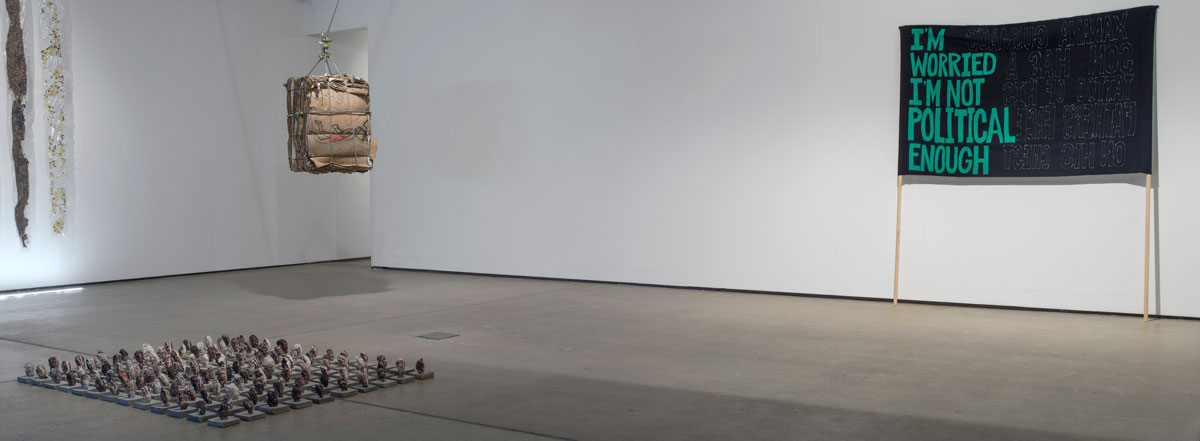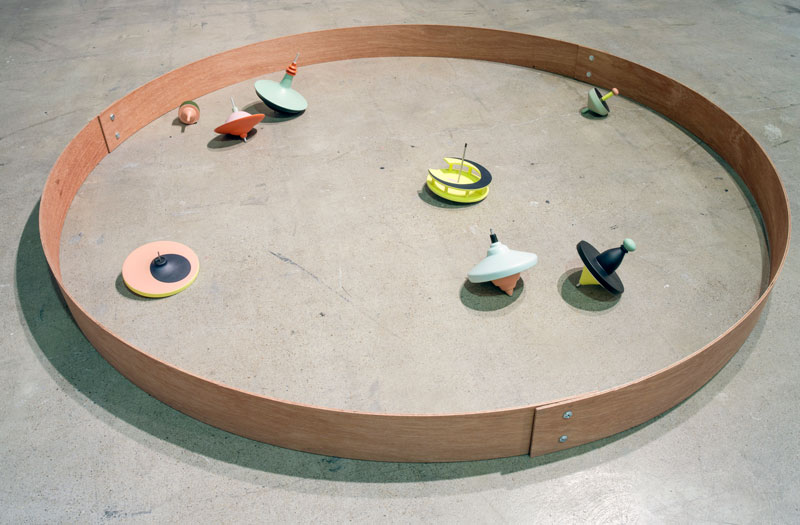
Material Politics takes its leave from a Peter Cripps exhibition held at Brisbane’s Institute of Modern Art in 1985 which centred on “recession art”– art that is based on “limited means of production, speed of production, and small size of constituent units.”[1] Given contemporary culture’s post-GFC, post-Brexit, post-Trump position – where, according to Lauren Berlant, “the languages of anxiety, contingency, and precarity” now take up the space that “sacrifice, upward mobility, and meritocracy used to occupy” – this exhibition, on paper at least, is timely.[2] Staged in conjunction with Material Politics, Céline Condorelli’s Corps à Corps (body to body) shares a similar emphasis on materials, though riffing more on the language of spatial design than the legacy of arte povera. Both exhibitions, curated by IMA directors Aileen Burns and Johan Lundh, present art-making as a type of political performance: one preoccupied with the use of at-hand materials, the other with revealing the support function of exhibition design.
Condorelli, a British artist based in London who has studied architecture as well as art, examines how relationships are articulated by the things that surround us, with a proclivity for art that can at once resemble a piece of furniture, a prop, a toy, and provide a practical solution to a display problem. Her work fits with the aggregation logic of recent installation art, where computer-assisted objects are posed site-specifically but also rather tentatively – as provisional structures that, echoing Internet searching, establish patterns of links between tropes rather than directing (and over-delivering) their meaning. Condorelli’s emphasis on reframing also speaks to the long life of relational aesthetics; indeed, her work is evocative of Liam Gillick’s practice, echoing his abstruse “minimalism meets neoliberal office design” aesthetic, by way of Dan Graham and Andrea Zittel.
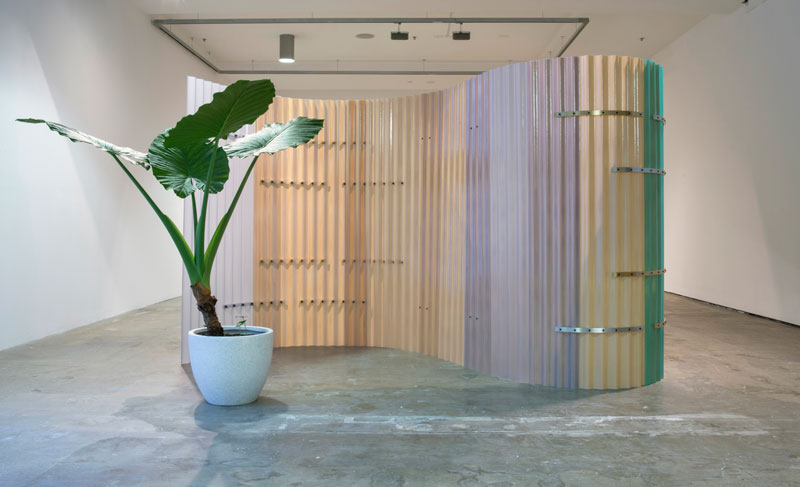
Upon entering Condorelli’s exhibition, viewers encounter Epilogue (2017) – a curved partition made from corrugated fibreglass positioned next to an on-trend household plant in a neutral-looking pot. One of many partition motifs in the exhibition, the work essentially serves to navigate people behind it, where Models for a Qualitative Society (2016) comprises about a dozen individually coloured and designed spinning tops – some resembling the artist’s large-scale circular platform sculptures – contained in a round wooden frame on the floor. In true relational-aesthetics style, the spinning tops according to the artist “function simultaneously as scale models for possible carousels (and other past and future playgrounds) and as elements allowing an exhibition to become a playground itself, inviting staff and visitors alike to play with them.”[3] The title of the work, Models for a Qualitative Society, is actually a nod to a late-1960s piece by the Danish artist and activist Palle Nielsen, who staged an adventure playground for children inside the Moderna Museet, Stockholm, over three weeks in October 1968. Whereas Nielsen appeared to give children free-reign of the museum space, Condorelli’s gift of interactive play is almost comical in its small-scale, rigor and relative sterility.
Nielsen’s project was revisited in 2007 by the theorist Lars Bang Larsen as a paradoxical combination of surrealist-like anarchy and disciplinary training, noting that its merging of playground activism and institutional critique was not an attempt to transform work into play so much as to put “play into work.”[4] What the French call la perruque – when an employee’s private tasks are disguised as work for her employer – is now the norm in many workplaces, where instead of living for the weekend, one fills as many work moments as possible with play. This idea, which is a key aspect of communicative capitalism, underpins Condorelli’s interest in parergonal devices – the usually disguised support structures that are everywhere, and are especially relevant in our public institutions. Her practice is an attempt to slow down the decision-making processes involved in art-making, to examine just how one goes about constructing common spaces and modes of serious intelligibility around play.
Echoes of Condorelli’s interest in precarious labour appear in Material Politics, particularly in the collaborative work by Jemima Wyman and Zach Blas, im here to learn so :))))) (2017). Blas, an American who lectures at Goldsmiths College in London, has a solo practice that revolves around technological determinism, normalisation and the implications of facial recognition software from a queer-identity perspective. His particular interest in masked protest makes for a fascinating collaboration with Wyman, who formerly based in Brisbane but now in Los Angeles has long been interested in the politics of fashion particularly in how patterned textiles can be used to connect military/activist clothing, female domestic labour and Islamic mosaics. The artists’ solo practices come together in a seemingly effortless way in this four-channel video work, which comprises three flat-screen monitors overlaid by a large projected patterned image rendered with Google DeepDream – an artificial intelligence program that recognises and reproduces shapes in existing pictures.
The literal centerpiece of the work of Blas and Wyman is Tay, an artificial intelligence Twitter chatbot created by Microsoft in 2016, which was hyped as a millennial-minded AI tool that could learn about the world through “conversations” with Twitter users. As one website reported, “It learned about human nature all too well: mischief-makers fed its artificial mind with cuss words, racism, Nazi sentiments and conspiracy theories. Within 24 hours, Microsoft had to pull Tay offline.”[5] A victim of trolling, Blas and Wyman reanimate the nineteen-year-old avatar across multiple screens, using the original Twitter profile picture of Tay to build a 3D character that philosophises on her miracle birth and quick death at the hands of Twitter users. In the artists’ hands, the rebooted Tay is posed phrenologically as a maltreated amorphous construction. On monitors on either side of Tay, assorted footage and imagery – from night-vision recording of military action to animated texts such as “well that’s not human lookin … it works tho” – create a distracted Internet sensibility, a vernacular world where inane ideas, extreme violence, bad spelling and kitschy pop exuberance find equal footing. While Tay’s miracle birth, death and artistic resurrection conjures Christian metaphors, this work is more ominous than uplifting, broken only momentarily when the ‘90s dance track Rhythm of the Night (1993) pumps randomly through the headphones to create a perfect interlude.
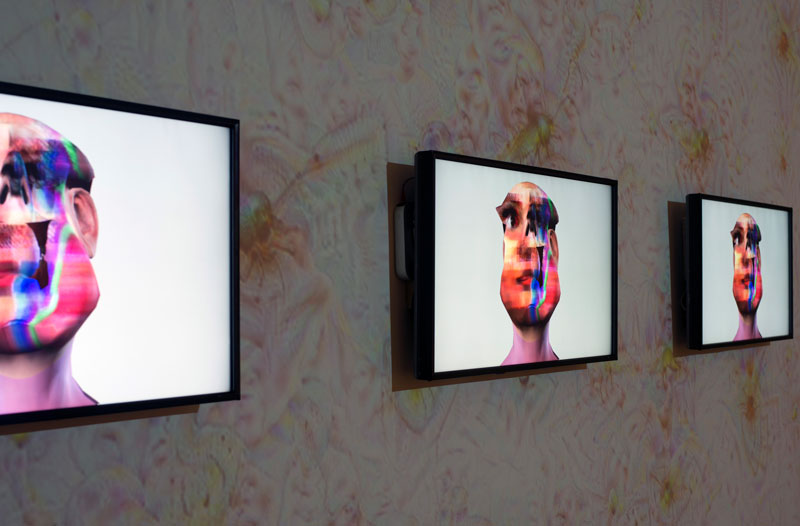
The other works in Material Politics fit more overtly with the “material” of the exhibition’s title, such as Keg de Souza’s the earth affords them no food at all (2017) – long, rectangular vacuum-sealed storage bags filled with iconic and not so iconic Australian foods, from indigenous macadamias, to foreign species of corn, to Barbeque Shapes – and Megan Cope’s Foundations II (2017), a large grid of Oyster shells set in concrete blocks. There is something silent, opaque, and even resistant about both of these works, as if to construe them as commentaries on ecology and sovereignty would be to undermine the importance of their physicality as works of art. In contrast, a double-sided banner work by Raquel Ormella that reads “I’m worried I’m not political enough” suggests an anxiety about making work that is understood as merely material. From the series, I’m worried this will become a slogan (1999–2009) this work, made with sewn wool and felt, no-doubt reflects reservations shared by many artists about the political message not reaching its intended target, or even about contemporary art’s implicit role in the commodification of identity politics. Ormella’s works have long implicated the viewer as a type of gallery-bound activist, with this piece dating from 1999 – before activist activity and streetwear credibility were thoroughly confused.
Archie Moore’s Bogeyman (2017) – a painted white sheet draped over a simple wooden structure – is the most resonant work here, in terms of the exhibition’s rationale. Constructed on-site, the work is simple and even beautiful up close, revealing Moore’s deft technical skills, which are routinely overlooked due to his conceptualist bent. Moore’s ghost evokes Ku Klux Klan and crucifixion imagery, but it could also just be a white sheet on a wooden structure made with stuff he bought from Bunnings. To my mind, only Jimmie Durham can match Moore’s ability to draw out racial prejudice, humour and poetry from quotidian forms. Here, like the ghost of Derrida’s ontology, this ghost seems at once present and absent, suggestive of Moore’s ongoing interest in representation and its limits – in the irreducible remainder that resists objectification. Given that his previous works have utilised perfumes, mistranslations and imaginary national flags, Moore is clearly compelled by such issues, concerned with how one locates the spiritual and conceptual residues of political action.
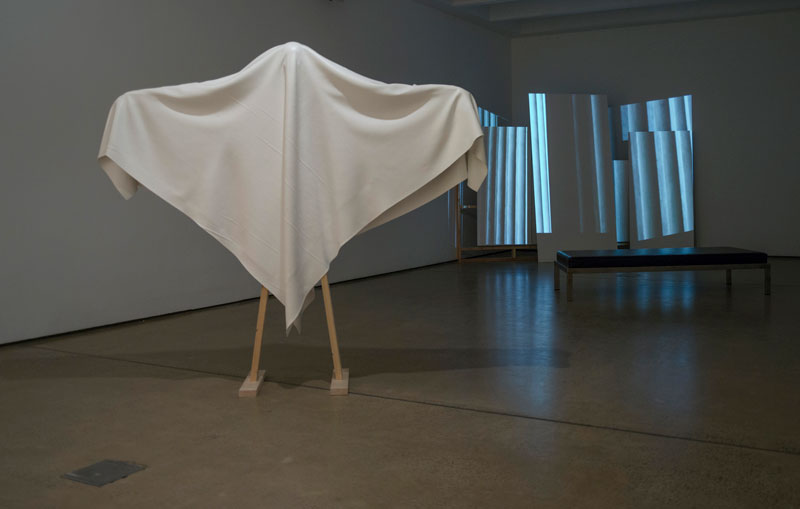
Given the importance of its theme – artists who find their political and socio-economic voice through materials that are readily at hand – Material Politics is a surprisingly “dainty” exhibition. I wonder if the theme itself might have been too broad, given that everything is material and, especially these days, political. Would a random selection of nine other artists who weren’t painters create similar exemplars of art’s political relationship with the everyday? This might be an unfair question; however, it is on these terms that Condorelli’s exhibition is instructive, addressing the gallery devices and procedures required to frame such issues – to distinguish “politics” from “thingness” only to reject such distinctions.
Footnotes
- ^ Peter Cripps, Recession Art and Other Strategies, Brisbane: Institute of Modern Art, 1986, p. 4.
- ^ Lauren Berlant, Cruel Optimism, Durhum: Duke University Press, 2011, p. 19.
- ^ Céline Condorelli, Models for a Qualitative Society, 2016, artist statement:http://www.celinecondorelli.eu/selected-work/models-for-a-qualitative-society/.
- ^ Lars Bang Larsen, “The Mass Utopia of Art Activism: Palle Nielsen’s The Model – A Model for a Qualitative Society” in Palle Nielsen, The Model – A Model for a Qualitative Society, Barcelona: MACBA, 2010, p. 50.
- ^ Alan Boyle, “Microsoft’s chatbot gone bad, Tay, makes MIT’s annual list of biggest technology fails,” geekwire.com, 27 December 2016: https://www.geekwire.com/2016/microsoft-chatbot-tay-mit-technology-fails/.

